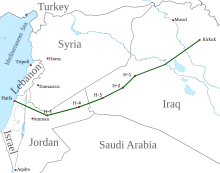Mosul–Haifa oil pipeline - Wikipedia, the free encyclopedia
 Map of Mosul–Haifa oil pipeline |
| Crude oil |
| Iraq Petroleum Company |
| 1932 |
| 1935 |
| 1948 (1954) |
| 942 km (585 mi) |
| 12 in (305 mm) |
The Mosul–Haifa oil pipeline (also known as Mediterranean pipeline) was a crude oil pipeline from the oil fields in Kirkuk, located in north Iraq, through Jordan to Haifa (now on the territory of Israel). The pipeline was operational in 1935–1948. Its length was about 942 kilometres (585 mi), with a diameter of 12 inches (300 mm) (reducing to 10 and 8 inches (250 and 200 mm) in parts), and it took about 10 days for crude oil to travel the full length of the line. The oil arriving in Haifa was distilled in the Haifa refineries, stored in tanks, and then put in tankers for shipment to Europe.
The pipeline was built by the Iraq Petroleum Company between 1932 and 1935,[1] during which period most of the area through which the pipeline passed was under a British mandate approved by the League of Nations. The pipeline was one of two pipelines carrying oil from the Kirkuk oilfield to the Mediterranean coast. The main pipeline split at Haditha with a second line carrying oil to Tripoli, Lebanon, which was then under a French mandate. This line was built primarily to satisfy the demands of the French partner in IPC, Compagnie Française des Pétroles, for a separate line to be built across French mandated territory.
The pipeline and the Haifa refineries were considered strategically important by the British Government, and indeed provided much of the fuel needs of the British and American forces in the Mediterranean during the Second World War.
The pipeline was a target of attacks by Arab gangs during the Great Arab Revolt, and as a result one of the main objectives of a joint British-Jewish Special Night Squads commanded by Captain Orde Wingate was to protect the pipeline against such attacks. Later on, the pipeline was the target of attacks by the Irgun.[2]
In 1948, with the outbreak of the 1948 Arab–Israeli War, the official operation of the pipeline ended when the Iraqi Government refused to pump any more oil through it.[3]
Oil pumping stations[edit]
These were named in numerical order going westwards, with the Iraqi stations denoted "K" after Kirkuk and the Trans-Jordanian stations "H" after Haifa.